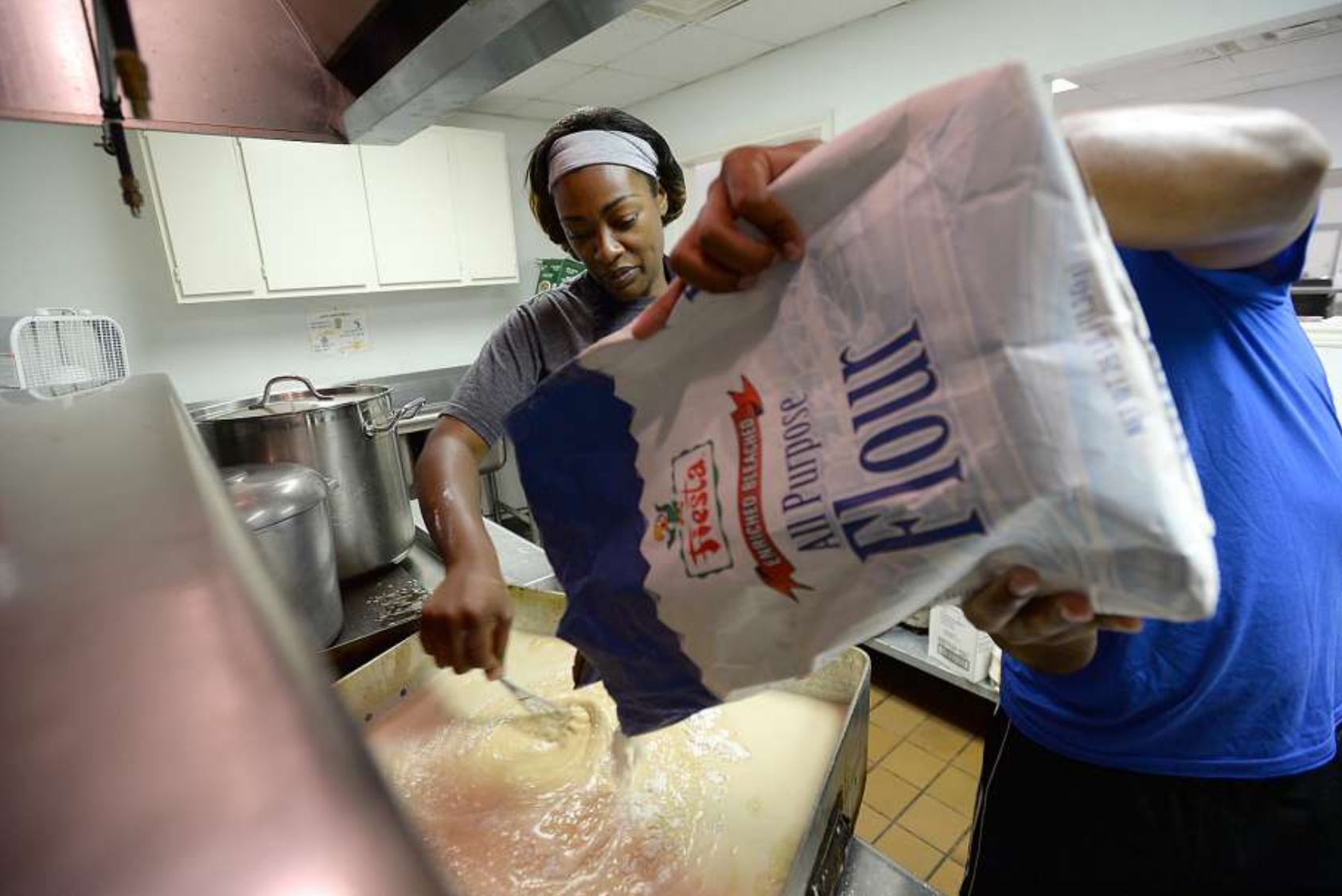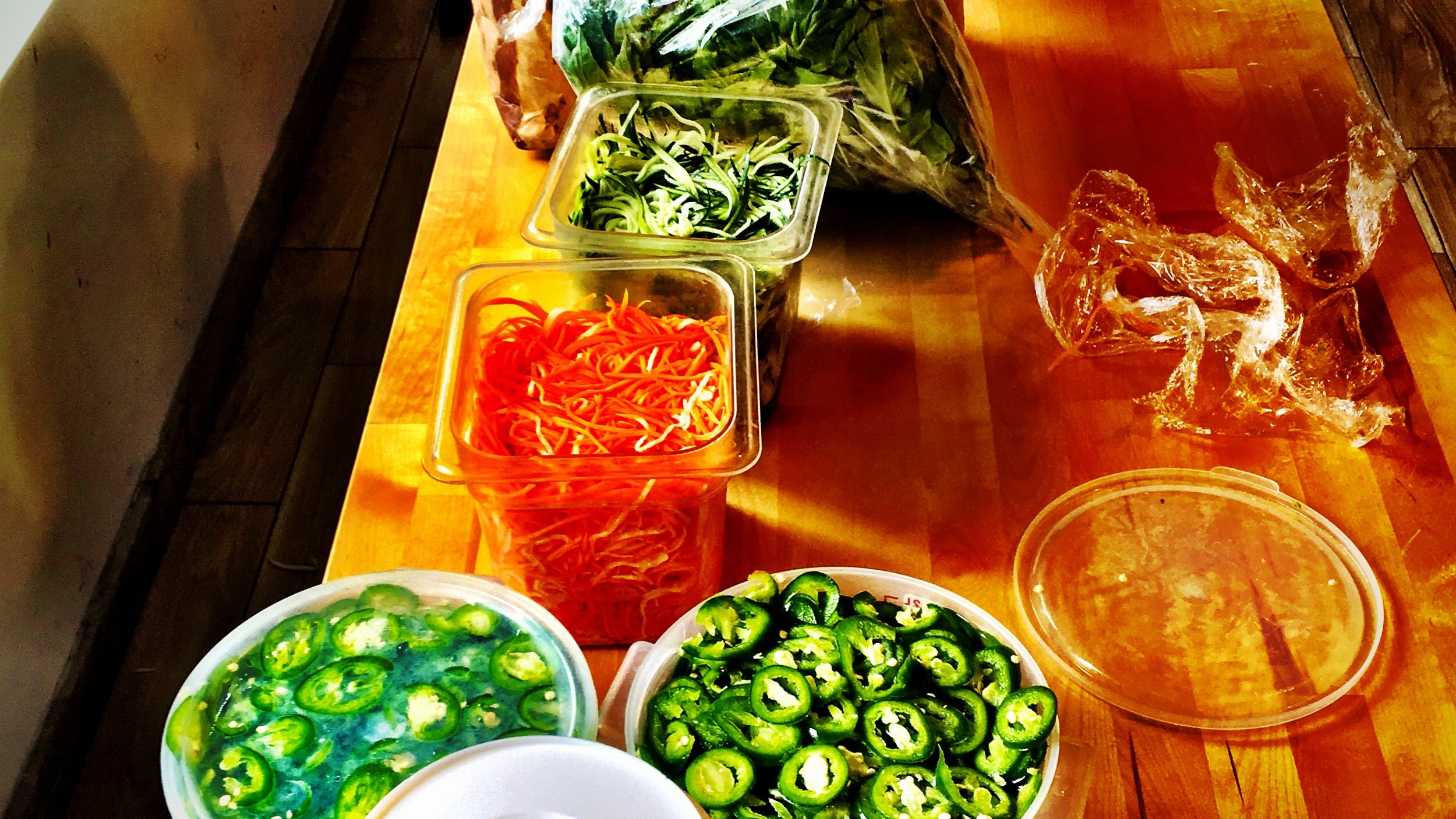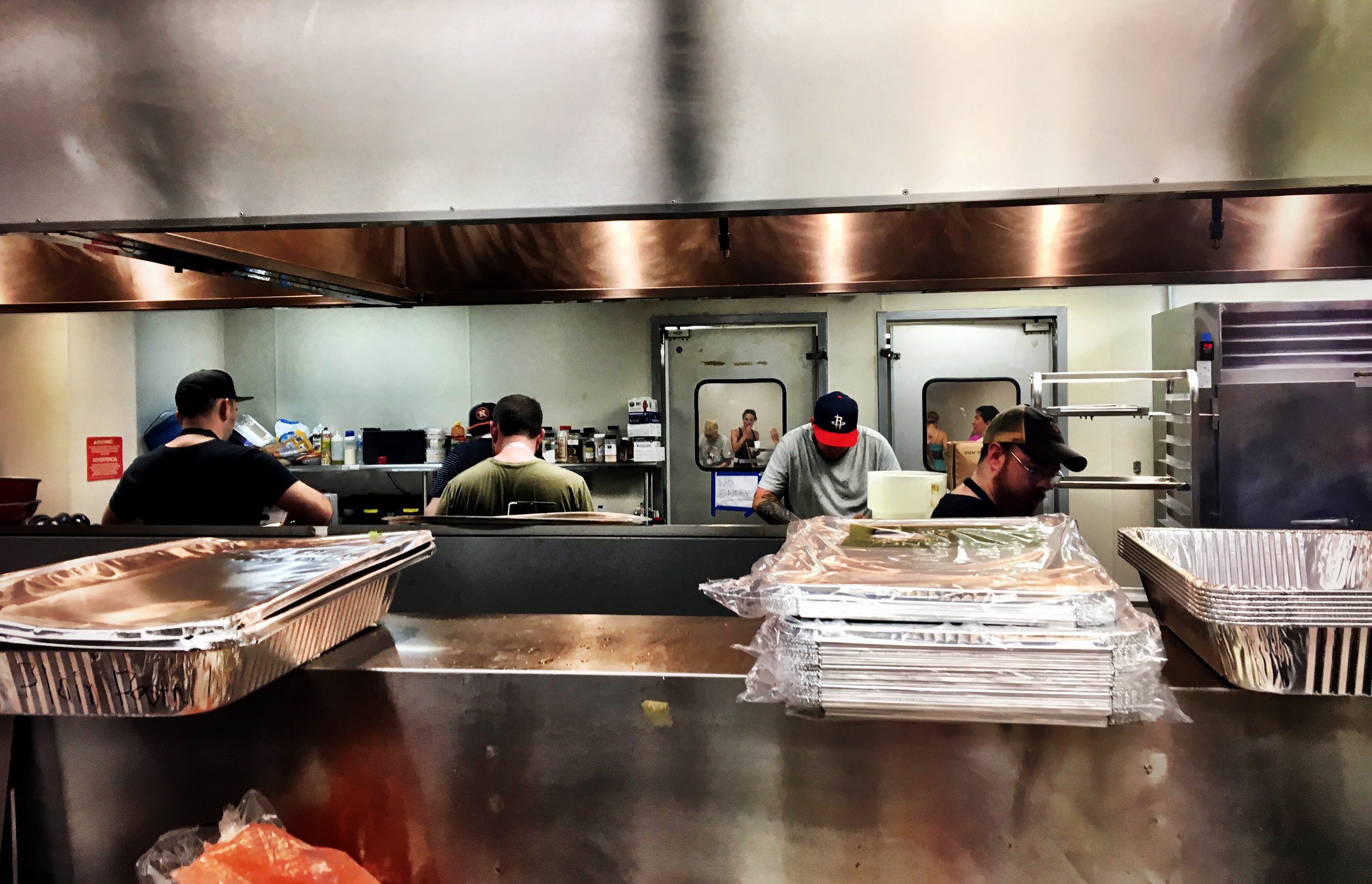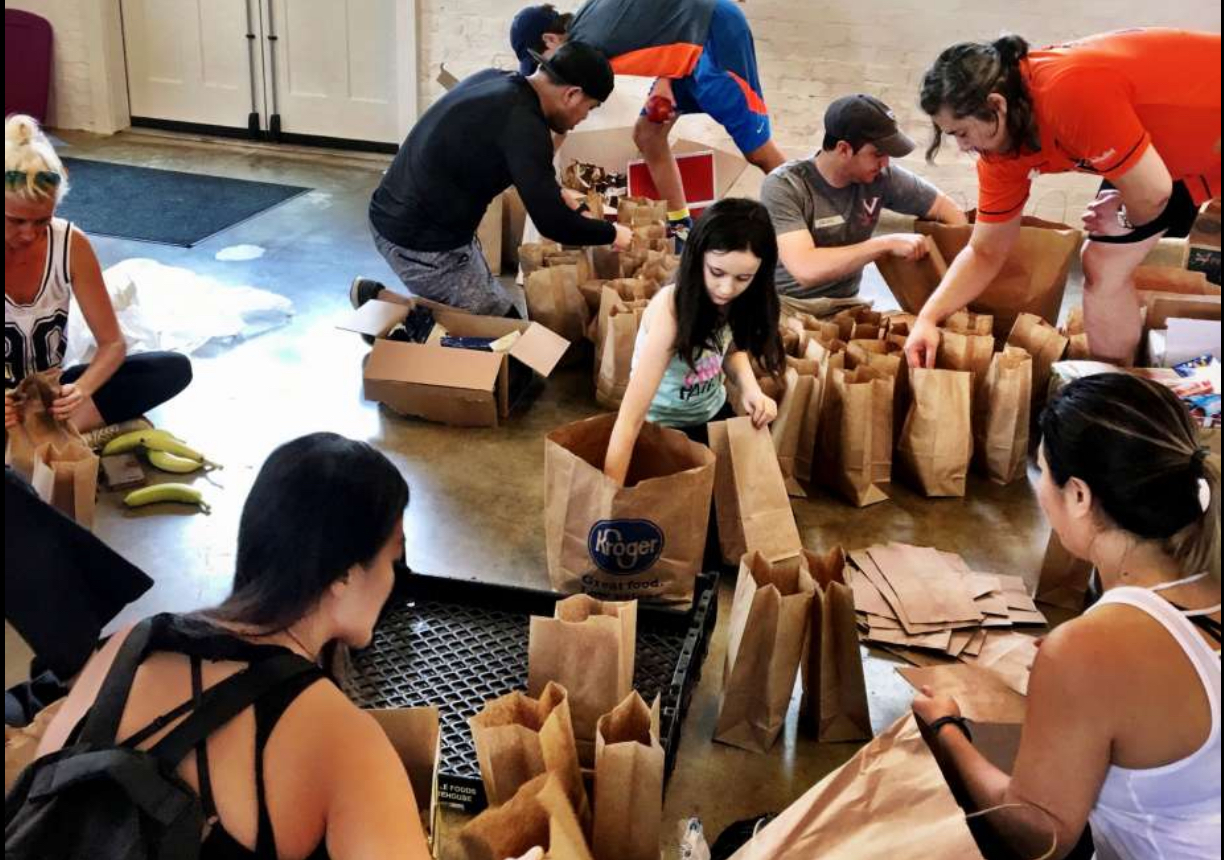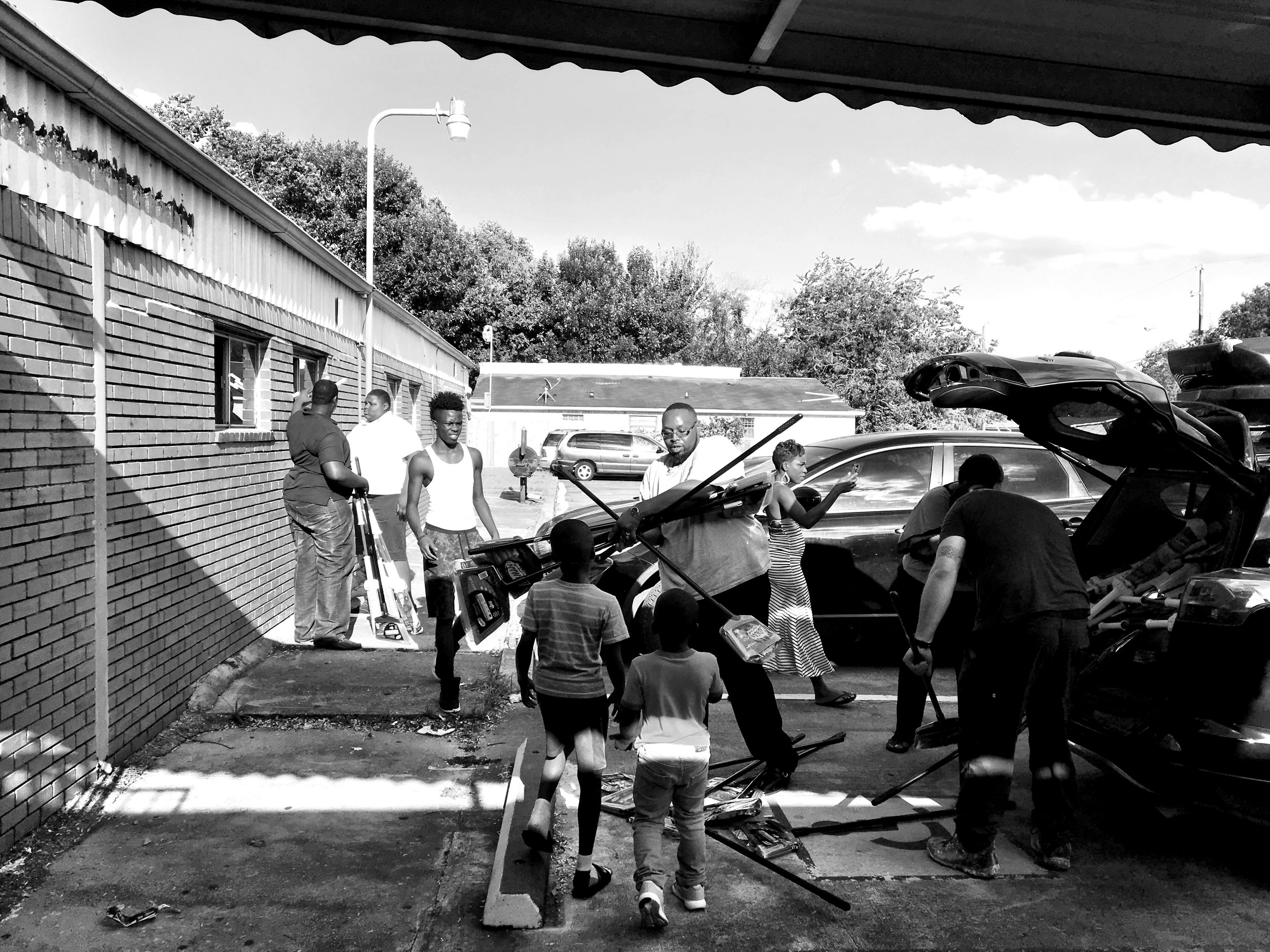Plant It Forward Farmers Growing Global Ingredients to Enrich Our Plates
Standing on the concrete floor in Plant It Forward’s warehouse, Christine Kengue, a farmer and refugee from the Republic of Congo, picks up a sky blue chef’s knife with her muscular right hand. In her left hand she holds a roselle calyx that resembles an acorn encased in scarlet flower petals.
She places her right thumb on top of the blade and her right middle and ring fingers just under the blade. With her right index finger she presses the tip of the calyx against the blue knife. Holding the bottom of the calyx with her left hand, she expertly rotates it, slicing off the top, then quickly removes the interior capsule. The intact sepals that remain now resemble a flower-petal cup Disney might design for the fairies of Neverland.
As she shares her knowledge, Christine laughs heartily at my astonishment. Thanks to Plant It Forward, the nonprofit that has been helping African refugees farm commercially in Houston since 2011, roselle has become one of my favorite ingredients—but I’ve always peeled the calyx slowly, petal by petal.
Compassionate Chaos: Harvey, Food, Rogue Relief, and Altruism
The history of Houston food
Immigration shaped the way our city eats
Houston is surfaces: highways, asphalt parking lots, glass skyscrapers, billboards, and miles and miles of suburban sprawl outlined by flat-topped, big-box stores. A city that many think has no past, that rose directly from the swamp, taming the surrounding prairies with concrete, ranch houses, and lawns of thick St. Augustine grass.
But surfaces lie. Surfaces reflect what we want to see. And often we do not want to see below them. Many would rather just tell the easy stories laden with clichés about oil tycoons, faux cowboys, rednecks, and bible-belted politicians. Others would rather ignore the multiple threads that connect us to the world and weave the rich, multicolored tapestry that lies just under the asphalt telling stories of diversity and discrimination.
But learn how a city eats, how it feeds itself year after year, and you will learn how it lives, its history, the stories of the hidden bonds that connect its citizens to each other and to the wider world. The stories of a city’s food are the stories of its humanity.
Long Point Road— One Road A Long History and Many Cuisines
On the surface, Houston’s Long Point Road is a typical stretch of concrete bisecting an aging sprawl of manufacturers and warehouses, garden apartments, neighborhoods of 1950s-to-’80s ranch houses and low-slung strip malls fronted by parking lots. But dig a little deeper and you’ll find that it has been shaped by global history: the German revolutions of 1848, the Mexican Revolution, Latin American’s Cold War politics, the rise of OPEC, oil booms and busts, the authoritarian regime of South Korean leader Park Chung-hee (1961–79) and much more. You’ll also discover that it is one Houston’s great food roads.
Farmers markets in Houston: A history
In March of 2012, surrounded by cherry laurel and loblolly pines, I helped three archaeologists prepare a fake dig along Buffalo Bayou. We buried the shells of oysters and rangia clams and the bones of fish, turtles, and alligators — the diet of the Karankawa, one of the indigenous peoples who once lived in the area.
We loosely covered the ecofacts with "black gumbo," a clay-heavy soil formed by marine life that decayed millions of years ago when the Gulf covered Louisiana and southeast Texas and from eroded bits of the Rocky Mountains — a loam that nourished Houston for years.
As we finished covering the relics, which students would unearth later that day, one of the researches told me that nearby, between Woodway Drive and Buffalo Bayou, there are the remnants of a market garden that helped feed Houston in the 1830s and 1840s.
The farm may have belonged to James Crawford, an émigré from the United States who owned land along Buffalo Bayou in what is now Memorial Park. In 1846, he sold the land to German immigrant Carl Julius Kolbe.
A Globe in Shades of Orange
Oranges remind me of summer. Maybe it’s because the orange spheres look like a child’s conception of the sun. Maybe it’s the years of seeing orange juice ads promoting a sunny, semi-tropical Floridian wonderland.
But oranges, and other citrus, are actually not a summer fruit—a fact I didn’t fully understand until I began shopping at Houston’s farmers markets, where from late October to March, if we are lucky, you can find a vast array of locally grown citrus: Meyer lemons, Republic of Texas oranges, Ruby Red grapefruits, Ujukitsus, Cara Cara Pink Navels, Satsumas, Moro blood oranges, pomelo, Buddha’s Hand and many others.
A Snapshot Of HOUSTON’S DIVERSE FOOD HISTORY
Downtown, a parking lot sprawls in the shadow of an elevated highway. Most days the yellow-lined concrete at the southeast corner of Franklin and Hamilton sits empty, but 81 days a year the lot bustles with cars and orange-clad Astros fans heading to Houston’s Minute Maid Park. On the surface, this parking lot at 1902 Franklin Avenue looks like thousands of others scattered across Houston’s urban landscape. But its history – the moment frozen in the photo to the left taken in 1943 by John Vachon for the Farm Security Administration– captures Houston’s food systems on the brink of dramatic change.
Early in his career, Mexican artist Diego Rivera painted seemingly familiar still-lifes of fruits and other foods. Later, his vision would turn outward, integrating workers in factories and fields into his now famous large-scale murals. For Houston legend Felix Tijerina, the odyssey was reversed. He left the fields and became a restaurateur creating what became familiar plates of food.
On the surface, Rivera’s journey seems to take the opposite tack of Tijerina’s journey but their journeys are more alike than they appear.
Best Restaurants for Lunch in the Heights — by a Longtime Resident
Having lived and worked in the Heights for almost 15 years, I’ve eaten a lot of lunches in what was Houston’s first suburb. Initially, good options were limited: walk-up fast-food joint Someburger, the now-shuttered Dacapo’s and Triple A, and Tex-Mex classic Teotihuacan, which is still serving a comforting array of fajitas, enchiladas, and shrimp dishes.
Within a few years, a new wave of lunch options began opening. The family-friendly Antidote at 729 Studewood — basically my second living room — opened in 2007 and offered a small selection of sandwiches, including one of the city’s better mozzarella, tomato, pesto sandwiches, which I’ve been splitting with my daughter for years.
In 2011, Revival Market and Down House opened, upping the Heights’s full-service lunch game by offering entrées, sandwiches and salads, often made with local ingredients. Eight years later, each is still at it.
With the solid groundwork laid by these pioneers, the Heights’ restaurant scene exploded. Now, there are too many good lunch spots to list. Below are my current favorites (a list that could look much different in a month or two).
0n the evening of Saturday, August 12, 1916, as ceiling fans whirred and a summer breeze blew through the second-floor windows, Houston police raided the fern- and palm-adorned Eagle Café and Chop Suey Parlor, at Prairie and Travis. As the cops entered the dining room, house band Frank J. Franc and his Futurist Sextet was playing a syncopated song while swanky diners slurped crab gumbo and briny Blue Point oysters before enjoying spring lamb with caper sauce, tenderloin trout with tartar sauce, or a toothsome chop suey. Led by District Attorney John Crooker, the police arrested the well-respected Japanese proprietor and serial entrepreneur Tsunekichi “Tom Brown” Okasaki for allegedly selling liquor without a license.
Even then, a century ago, one needed to look no further than its restaurants to see that Houston was and would remain a city of immigrants.
In May 1979, a Grumman Gulfstream II rolled up to a purple carpet laid out on the tarmac of Houston’s Hobby Airport. Fashion designer Karl Lagerfeld stepped from the plane into the swelling chords of the Rocky theme song being played by the Kashmere High School Marching Band.
Lagerfeld had come to premiere his newest collection, not in Paris or New York City, but at Houston’s Neiman Marcus, which anchored the Galleria; and he had come to party at Gilley’s, the multi-acre Pasadena honkytonk that engulfed the heart of Houston’s refineries and chemical plants.
Texas, Houston in particular, was experiencing the peak of yet another oil boom. Texas chic was in vogue. Dallas, which had premiered in 1978, was one of the most popular shows on TV, and Aaron Latham’s 1978 Esquire article on Gilley’s, “Ballad of the Urban Cowboy,” was being turned into a movie starring John Travolta and Debra Winger.
EAT YOUR CARROTS, PLEASE
In the fall of 1986, during my first trip home from college, I was standing in my mom’s kitchen—the kitchen where my grandmother once stood—scraping and eating the brown fond and rendered fat from the bottom of a roasting pot. My mom, at my request, was making what had been my favorite home-cooked meal during high school: roasted pork loin. I’m not sure if what I savored then was the pork loin—now one of my least favorite cuts of meat, because it’s often too lean—or those umami-rich scrapings. I’m guessing the latter. Either way, those post-childhood tastes were my first hints that I had a culinary heritage.
Though my family was intimately involved with our food system—my maternal grandfather was a farmer and, at different times, owned a grain elevator and an Allis-Chalmers tractor dealership; my paternal grandfather co-owned the local grocery store—the dining room didn’t form a major backdrop for my upbringing. More than my family’s kitchen, I remember cornfields, pigpens, grain silos, and grocery store walk-ins.
My mom made sure there was always a sandwich in my lunchbox and supper on the table, but, as I learned later, she didn’t really like to cook. She had come of age as a homemaker in the early 1960s when the convenience of opening a can of Campbell’s soup and following a recipe from Better Homes and Gardens were ultimate expressions of modern, industrial America. And later, as a single mom, that was often all she had time for. One of my favorite meals growing up, one we ate at least once a week, was a quick concoction she called tuna curry: a can of Campbell’s cream of mushroom soup, a can of Chicken of the Sea tuna, some McCormick curry powder heated together in a pan and served over Minute Rice.
When Amazon announced that it is buying the Whole Foods chain for $13.7 billion, I was intrigued — and also concerned. The idea, apparently, is to make the grocery industry more efficient and to grow the burgeoning grocery-delivery business.
Efficiency is nothing new to grocery stores. For the last hundred years, it's driven changes to the industry. (Or "disruptions," as tech entrepreneurs say.) In general, the companies become ever larger, able to deliver food ever more cheaply.
Consider Houston's grocery history. During the first quarter of the 20th century, small mom-and-pop grocery stores ruled. In 1922, Houston had 775 grocery stores to serve a population of 138,276: That works out to one store per 178 residents.
A few were local and regional chain stores, but the majority were independently owned. Most offered a limited selection: flour, tea, coffee, sugar, and pickles sold in bulk, a few canned items, and maybe some produce or meat. Lack of good refrigeration limited your choices. Most residents lived within walking distance of a store, and many stores offered delivery.
In the summer of 1972, my mom packed the trunk and backseat of our 1966 pale blue Ford Mustang with suitcases, toys, and family heirlooms she didn’t trust to the movers. I slid into the black vinyl front seat holding a teddy bear, a ficus resting on the floorboard between my knees. At four, I was about to embark on my first major road trip.
My parents had recently divorced and my mom had decided to leave Houston and move in with her father, a Midwestern farmer, in her hometown of Elsberry, Missouri. In pictures from that time, my mom was beautiful, sporting long brown hair and clothes that were in fashion in the late ‘60s and early ‘70s. She was 28 and about to drive over 800 miles alone with a four-year old in an un-air-conditioned car in the middle of summer. In 1972, divorce was still fairly rare, and even though the U.S. was in the midst of a major cultural revolution, it was still unusual for a woman to travel that far by herself. Looking back, I realize this trip was a courageous undertaking.
I imagine that Tanya Tucker’s “Delta Dawn” was playing on the radio as the Houston skyline faded in the background; the song was one of my mom’s favorites. I don’t remember what was actually playing on the radio that day. My memories from that time period, though poignant, are also, understandably, vague—pieced together from what I actually recall, the stories my mom has told, and my own imagination.
On an isolated, hard-packed, red clay road near Lake Livingston, not far outside Houston, a man pulled his car behind us and followed close enough for me to occasionally see his face. My mom was clearly nervous. As I remember it, she outran him, red-clay dust devils spiraling behind our car. Maybe that last detail is a result of watching too many episodes of The Dukes of Hazzard, but there was no doubt he was following us and that my mom felt threatened. Some time after we lost him, the Mustang overheated. I was excited because I got to ride in a tow truck, but looking back, I’m sure my mom was scared—scared for herself and her young son alone on a road somewhere in America.
During a recent trip to New York City, I took a Sunday morning walk in Harlem: east on 145th Street, then south on Convent Avenue. The swaying rhythms of gospel music drifted from the Greater Tabernacle Baptist Church on the corner of Convent and 144th. A verdant apple tree grew in the yard of a 19th-century brownstone. I eventually wandered back west to the more commercial Amsterdam Avenue and into Food Hut Caribbean Cuisine, where I ordered jerk chicken, oxtails, and collard greens from the steam trays behind the glass counter.
Back in the apartment we’d rented for the weekend, I opened the two Styrofoam containers of food and was viscerally struck by something I had previously thought I understood: how similar Caribbean food was to Southern cuisine, how the roots of both go back to slavery, Africa, and beyond. Sometimes it takes distance — in this case, over 1,400 miles—to recognize what’s right in front of you.
On April 6, 1898, Beauty Leno was born along the banks of the Brazos River to African-American sharecroppers. When she was in her mid-20s, she moved to Independence Heights, then an independent suburban community bordering what is now I-45 and I-610 just north of the Houston Heights. In her story, you find causes and solutions for the food deserts that have developed in what is called the Horseshoe, a swath of neighborhoods located between 610 and Beltway 8 to the north, south, and east of the city: Independence Heights, Houston Gardens, Settegast, Clinton Park, and Sunnyside.
When Beauty moved to the Houston area, she brought her country ways with her and raised vegetables and chickens, producing much of her own food, and eventually opened two businesses, including her own barbecue restaurant. But as the 20th century progressed, many of those rural foodways where lost, which was one of the many factors that lead to the evolution of urban food deserts.
However, Beauty’s family kept her land, and with the help of CAN DO Houston and other organizations, they built a community garden that now helps bring quality food to the neighborhood.
CAN DO Houston’s overall mission is to reduce and prevent childhood obesity. Under the leadership of Executive Director Dr. Jasmine J. Opusunju, CAN DO takes a comprehensive approach to this growing health crisis by addressing the core issues underlying the problem.
Like Beauty Leno before her, Dr. Opusunju approaches life with a can-do, entrepreneurial spirit, which she no doubt gets partly from her mother, who emigrated from Nigeria and started a successful food importing company.
On a rainy Friday afternoon, I sat down with Dr. Opusunju at Double Trouble, another business run by entrepreneurial women. With an infectious enthusiasm and passion for her mission, she discussed food deserts, CAN DO Houston’s Healthy Corner Store initiative, and much more.
When you drive onto Countryside Farm, nestled in the low, scruffy hills south of Austin, you’re greeted by two shaggy llamas and a cacophony of fowl sounds. According to Countryside’s owner, French expatriate Sebastien Bonneu, the llamas “keep the coyotes and other predators away and they’re guaranteed not to eat my birds.” Llamas, unlike Bonneu, are vegetarians.
Bonneu, a French-trained baker turned chef then farmer, raises fowl and pigs for restaurants and families throughout central Texas. Like the llamas and the land around him, Bonneu is scruffy, stubborn, and unconventional. Tufts of curly, unkempt, dark hair and a beard frame his intense eyes. He is quick with a joke or an opinion delivered in a hectic, heavy French accent.
He approaches farming with the passion of an artist, constantly experimenting with new breeds, feeds, and techniques, trying to produce the best meat he can. Over the course of two visits, photographer and chef Richard Knight and I sat down with Bonneu and talked—well, we did more listening than talking—about his approach to farming and food, while sampling an array of his well-crafted charcuterie, including smoked duck breast, blood sausage, pâté, and liver mousse.
THE VISCOUS VEIL: SCENES AND THOUGHTS FROM A BOUCHERIE
As you head south on Hempstead Highway from 11th Street — following a route German farmers once took to bring their harvest from Spring Branch to the farmers market held where Market Square Park now stands — you pass rust-dappled, slightly overgrown industrial buildings and a few new townhouse developments rising from the roughened coastal prairie.
As the cracked concrete narrows and curves under a railway bridge, a large iron skeleton of what could be a new warehouse stands almost majestically on a rise overlooking the highway.
This is the site of the recently announced Railway Heights Market, a planned 25,000-square-foot food and retail destination that will also include a 13,000-square-foot beer garden with a stage for live music, a half acre of greenspace, 15,000 square feet of coworking space and, eventually, a 600-car automatic parking garage.


